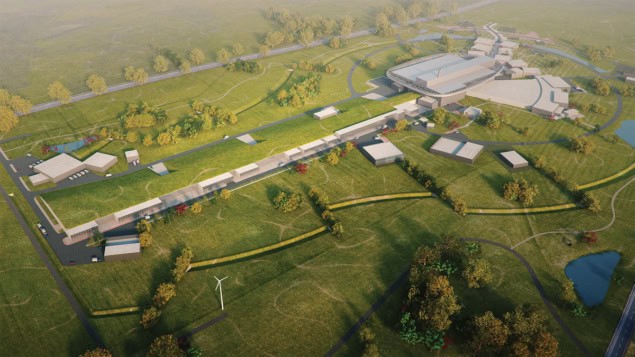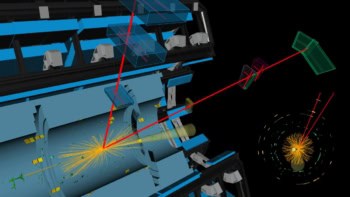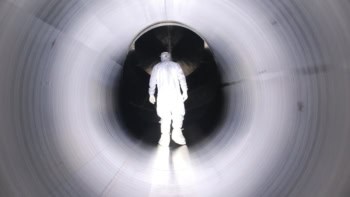While the European Spallation Source will be the most powerful source of neutrons in the world, David Burman looks at a proposal to modify the facility’s linear accelerator to also produce an intense beam of neutrinos

The €2bn European Spallation Source (ESS), currently under construction in Lund in southern Sweden, will be the world’s most powerful source of neutrons when it fires up in the early 2020s. With an average beam power of 5 MW, the ESS’s main focus is generating copious amounts of neutrons for a range of experiments from biology to condensed-matter physics. Yet there are plans afoot to also make the ESS a leading particle-physics lab and produce the world’s most intense beam of neutrinos.
The ESS Neutrino Super Beam (ESSnuSB) consortium – a team of 50 physicists in 11 European countries, led by Tord Ekelöf at Uppsala University, Sweden, and Marcos Dracos from Strasbourg University, France – say that an intense neutrino beam could be created by doubling the beam power of the ESS to 10 MW. The cost is estimated at €500m (plus €700m for a neutrino detector) – a sum just less than the actual cost of the ESS itself.
Neutrons will be generated at the ESS via a 2 GeV superconducting linear proton accelerator. Those protons are sent to a tungsten target and, in the process of spallation, produce neutrons. The proton beam at the ESS is delivered in 14 pulses every second. Each pulse is 3 ms long, meaning that the linear accelerator is only active about 4% of the time. The facility’s radiofrequency power generators deliver 125 MW of power during each pulse.
Ekelöf and colleagues say that by doubling the number of pulses in the ESS’s linac to 28 per second, thereby increasing the average beam power to 10 MW, half of this beam could be used to generate neutrinos. “In this way the accelerator will be used 8% of the time, which is still quite feasible technically,” says Ekelöf. “Linear superconducting accelerators currently exist that are used 100% of the time.”
There are, however, several technical challenges in doubling the ESS’s beam power. One is to work out the details of how to add more accelerator pulses to double the average power of what will already be the most powerful accelerator in the world. The doubling of the ESS accelerator power will require an increased cooling capacity in the power generators and in the accelerating cavities to compensate for the increased heat dissipation. And the capacity to operate at a higher frequency will also require some modifications to the power generators, such as increasing the power of their capacitor-charging current sources.
The ESSnuSB consortium is now looking to complete a design study via an EU COST Action – a way to co-operate and co-ordinate nationally funded research activities. When a design study and technical design have been carried out – a process that could take five years – the consortium will then look for funding. “It is clear that the additional cost that ESSnuSB represents will require strong political backing,” Ekelöf admits. “Yet it will be the only project to continue frontline experimental neutrino physics in Europe, a field in which Europe has a long tradition.”
Neutrinos oscillate between three different kinds of “flavours” – electron, muon and tau. To generate the neutrino beam, the protons would be made to hit a titanium target to produce pions that decay into muons and muon neutrinos. The neutrinos would be detected using a huge underground water-based Cherenkov detector located in the Swedish Dalarna region about 540 km north of Lund. There are two other planned projects pursuing the same goals as the ESS neutrino idea: the Deep Underground Neutrino Experiment in the US and Hyper-Kamiokande in Japan. These two projects are more advanced in their planning, yet the ESS neutrino project will be unique, thanks to the intense neutrino beam created by the ESS accelerator. It is this high intensity that will allow researchers to place the neutrino detector three times further away than is usual, something that will reduce systematic errors.
However, before the neutrino project at the ESS can get off the ground, the issue of who will pay for the upgrade to the ESS’s accelerator will need to be ironed out. According to Ekelöf, such an investment can only be achieved by an international agreement similar to that made between the 11 countries behind the ESS. Ekelöf claims that the ESS management are broadly supportive of the proposal, adding that they have agreed “to provide information and general support for the ESSnuSB collaboration’s ongoing studies”.
Allen Weeks, head of communications at the ESS, says that while they are focused on delivering neutrons for the foreseeable future, “the science [behind the consortium’s proposal] is very interesting and exciting for the neutron and particle physics communities”.



